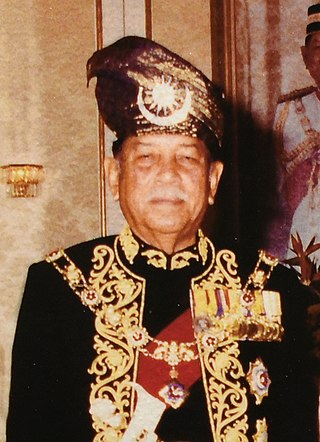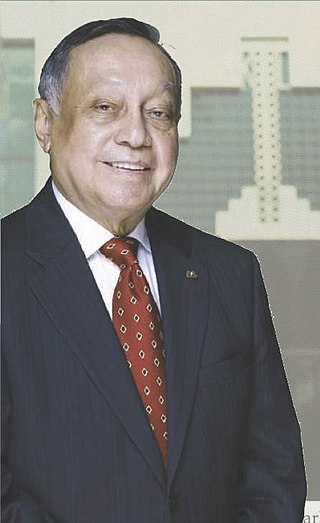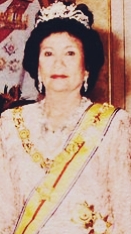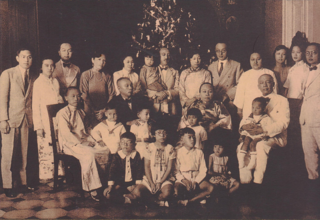Related Research Articles
The Malay language has a complex system of styles, titles and honorifics which are used extensively in Brunei Darussalam, Malaysia and Singapore.

Tuanku Sir Abdul Rahman ibni Almarhum Tuanku Muhammad was Yang di-Pertuan Besar of Negeri Sembilan from 1933, and the first Yang di-Pertuan Agong of the Federation of Malaya from 1957, until his death in 1960.

Tuanku Ja’afar ibni Almarhum Tuanku Abdul Rahman was Yang Di-Pertuan Besar of Negeri Sembilan from 1967 until his death in 2008, and the tenth Yang di-Pertuan Agong, from 1994 to 1999.

Tunku Puan Besar Hajah Kurshiah binti Almarhum Tunku Besar Burhanuddin was the Tunku Ampuan Besar or Queen of Negeri Sembilan. She also served as the first Raja Permaisuri Agong of Malaya between 1957 and 1960.

Sultanah Hajah Bahiyah binti Almarhum Tuanku Abdul Rahman was the Sultanah of Malaysian State of Kedah from 1958 until her death in 2003 and served as the fifth Raja Permaisuri Agong of Malaysia from 21 September 1970 until 20 September 1975.

Tuanku Muhriz ibni Almarhum Tuanku Munawir is the eleventh Yang di-Pertuan Besar of Negeri Sembilan, Malaysia. He is the only son out of six siblings of royal spouse, the ninth Yang di-Pertuan Besar of Negeri Sembilan Tuanku Munawir and his spouse, Tunku Ampuan Durah.
Melewar Industrial Group Berhad is a manufacturing company in Malaysia. It is owned by the family of its late founder and chairman Tunku Tan Sri Abdullah ibni Almarhum Tuanku Abdul Rahman from the Negeri Sembilan royal family and engages in the manufacturing and trade of steel products in addition to investments. It has 461 employees and is listed on the Kuala Lumpur Stock Exchange. Presently Melewar Industrial Group Berhad has an installed capacity of more than 22,000 m/tons per month with the ability to manufacture pipes from 10 mm to 355 mm O.D. MIG's products are widely used in the construction, furniture, automotive, bicycle, and engineering industries.
Adrian Willem Ban Kwie Lauw-Zecha, better known as Adrian Zecha, is an Indonesian hotelier and founder of several international hotel companies including Regent Hotels, GHM Hotels, Aman Resorts, and Azerai Resorts, among others. Zecha was also part-owner of the renowned London’s Dorchester Hotel, and Bangkok’s The Sukhothai Hotel through his investment company.

Tan Sri Tunku Abdullah ibni Almarhum Tuanku Abdul Rahman was a notable Malaysian businessman and a founder of the Melewar Group Berhad of companies.
Tunku Besar Burhanuddin ibni Almarhum Yamtuan Antah was a member of the Negeri Sembilan royal family and once served as regent of Negeri Sembilan. His father was Yamtuan Antah ibni Yamtuan RadIn, who served as the 6th Yamtuan Besar from 1869 to 1888. Tunku Burhanuddin's elder brother, Tuanku Muhammad became the 7th Yamtuan Besar and the first to use the title Yang di-Pertuan Besar upon Yamtuan Antah's death.

Tunku Ampuan Najihah binti Almarhum Tunku Besar Burhanuddin was the Tunku Ampuan of Negeri Sembilan. She was formerly the Tunku Ampuan Besar or Queen consort of Negeri Sembilan from 1967 to 2008. She also served as Raja Permaisuri Agong of Malaysia between 1994 and 1999.
Tunku Zain Al-'Abidin ibni Tuanku Muhriz, , more popularly known as Tunku 'Abidin Muhriz, is the second son of the reigning Yang di-Pertuan Besar of Negeri Sembilan in Malaysia, Tuanku Muhriz ibni Almarhum Tuanku Munawir and the reigning Tunku Ampuan Besar of Negeri Sembilan, Tuanku Aishah Rohani binti Tengku Besar Mahmud.

Tunku Tan Sri Imran ibni Almarhum Tuanku Ja’afar is a member of Negeri Sembilan royal family who is the Tunku Muda Serting. He is the grandson of the first King of Malaysia, the late Tuanku Abdul Rahman. His father the late Tuanku Ja'afar, was also the 10th King of Malaysia. He was born as the second son of Tuanku Ja’afar, the 10th Yang di-Pertuan Besar of Negeri Sembilan, Malaysia. He is often unofficially known in English as Prince Tunku Imran.

The Indonesian Malaysians are Malaysian citizens of Indonesian ancestry. Today, there are many Malaysian Malays who have lineage from the Indonesian archipelago and have played an important role in the history and contributed to the development of Malaysia, they have been assimilated with other Malay communities and are grouped as part of the foreign Malays or anak dagang in terms of race. The Malaysian census does not categorize ethnic groups from the Indonesian archipelago as a separate ethnic group, but rather as Malay or Bumiputera.

The Lauw-Sim-Zecha family is an Indonesian family of the 'Cabang Atas' or the Chinese gentry of the Dutch East Indies. They came to prominence at the start of the nineteenth century as Pachters, Landheeren (landlords) and Kapitan Cina in the colonial capital, Batavia, and in the hill station of Sukabumi, West Java. The family is of mixed Peranakan Chinese and Indo-Bohemian descent.
Francisca Louisa Zecha (1848–1939), usually known as Louisa Zecha, was a prominent, colonial Indonesian community leader and the Indo-Bohemian matriarch of the Lauw-Sim-Zecha family, part of the 'Cabang Atas' gentry of the Dutch East Indies. She attracted significant attention due to her controversial interracial marriages to two Peranakan Chinese magnates, Lauw Tek Lok, Luitenant der Chinezen of Bekasi and Sim Keng Koen, Kapitein der Chinezen of Sukabumi. The posts of Kapitein and Luitenant der Chinezen were high-ranking civil administration positions in the Dutch colonial bureaucracy. Zecha's community leadership, philanthropy, personal bravery and longevity earned her widespread respect and admiration in colonial society by the time she died in 1939.
Sim Keng Koen, Kapitein der Chinezen was a Chinese-Indonesian bureaucrat and the patriarch of the influential Lauw-Sim-Zecha family, part of the 'Cabang Atas' gentry of the Dutch East Indies. He was married to Louisa Zecha, the Indo-Bohemian widow of Sim's former employer, Lauw Tek Lok, Luitenant der Chinezen of Bekasi.

The Minangkabau Malaysians are citizens of the Malaysia whose ancestral roots are from Minangkabau of central Sumatra. This includes people born in the Malaysia who are of Minangkabau origin as well as Minangkabau who have migrated to Malaysia. Today, Minangkabau comprise about 989,000 people in Malaysia, and Malaysian law considers most of them to be Malays. They are majority in urban areas, which has traditionally had the highest education and a strong entrepreneurial spirit. The history of the Minangkabau migration to Malay peninsula has been recorded to have lasted a very long time. When the means of transportation were still using the ships by down the rivers and crossing the strait, many Minang people migrated to various regions such as Negeri Sembilan, Malacca, Penang, Kedah, Perak, and Pahang. Some scholars noted that the arrival of the Minangkabau to the Malay Peninsula occurred in the 12th century. This ethnic group moved in to peninsula at the height of the Sultanate of Malacca, and maintains the Adat Perpatih of matrilineal kinships system in Negeri Sembilan and north Malacca.
References
- 1 2 Kee, Hua Chee (August 21, 2008). "Melewar Group's Tunku Abdullah dies - Nation | The Star Online". www.thestar.com.my. The Star. Retrieved 14 July 2017.
- 1 2 3 "Honorary Patron". Central School of Classical Ballet. Retrieved 14 July 2017.
- ↑ Tan, Mely G. (1963). The Chinese of Sukabumi: A Study in Social and Cultural Accommodation. Cornell University.
- ↑ Barnes, Clive (April 27, 1961). "Ballet » 27 Apr 1961 » The Spectator Archive". The Spectator Archive. The Spectator. Retrieved 14 July 2017.